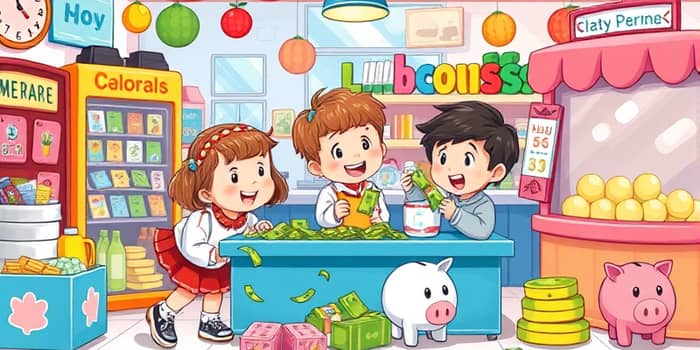Financial literacy is one of the most valuable life skills parents can impart. Introducing money concepts early helps children develop confidence, responsibility and long-term planning habits. However, traditional lectures on currency and budgeting can feel dry and abstract. By gamifying these lessons, you transform learning into an adventure that engages young minds. When kids enjoy exploring financial topics, they are more receptive and adaptable. This article outlines strategies and activities to empower your children through hands-on learning through games and fun challenges.
Why play-based learning works
Children are naturally curious and love to explore through play. By turning money lessons into playful experiences, you tap into their intrinsic motivation and imagination. Research shows that games help solidify abstract concepts by breaking them into concrete, memorable steps. With each round of pretend shopping or savings challenge, your child deepens understanding of value, trade-offs and delayed gratification. Furthermore, play fosters creativity and collaboration, essential qualities for financial success. Ultimately, you are building financial decision-making skills in a supportive, pressure-free environment where mistakes become learning opportunities.
Age-appropriate money activities
Not all money games suit every developmental stage. Tailoring activities to your child’s age ensures they grasp the right concepts at the right time. Younger children focus on coin recognition and basic counting, while older kids tackle budgeting, entrepreneurship and even interest calculation. Below is a quick reference to help you choose the most effective activities for each age range.
Essential money skills developed through play
Play-based activities can cover a broad spectrum of financial skills. For young learners, identifying coins and bills lays the groundwork for future budgets. As kids progress, they learn to compare prices, calculate change and make spending decisions. Entrepreneurial ventures like lemonade stands or toy sales teach profit, negotiation and customer service. Introducing savings jars or digital piggy banks helps set visual savings goals and challenges that motivate them to delay gratification. Even teens practice real-world tasks like virtual house-hunting to explore loans, down payments and interest rates.
Beyond individual skills, play nurtures essential mindsets. Children discover how to weigh risks, adapt to unexpected scenarios and appreciate long-term planning. These lessons build resilience and resourcefulness—traits at the heart of financial success. When you combine structured games with reflection discussions, kids internalize sound money habits and develop trust in their decision-making abilities. This process encourages them to view money not just as numbers, but as a tool to shape their future.
Practical tips for parents and educators
To maximize engagement and learning impact, integrate financial play into daily routines and family traditions. Consistency and modeling are key: children mimic adult behaviors, so demonstrate responsible money management in front of them. Make these activities part of weekend plans or after-school sessions, rather than once-in-a-blue-moon events. Below are simple strategies to keep the momentum going.
- Use real currency and play money together to highlight real-world value comparisons during activities.
- Turn errands into learning moments, such as calculating totals at the grocery store or negotiating discounts.
- Create a reward system for saving milestones, linking effort with tangible outcomes.
- Invite friends or neighbors for group challenges, fostering social collaboration and healthy competition.
- Rotate games and introduce new scenarios periodically to maintain excitement and curiosity.
Resources and tools to get started
A variety of platforms and materials can support your mission to teach money concepts through play. Whether you prefer digital solutions or tactile experiences, choose tools that align with your child’s interests and learning style. Interactive websites can supplement hands-on games, while printable worksheets offer structure for reflection and tracking progress.
- Online games from the Council for Economic Education and ABCya focusing on saving and spending.
- Financial board games like Monopoly, Payday and The Game of Life for deeper strategy exploration.
- Printable worksheets and family templates to record budgets, track earnings and set savings goals.
- Simple apps designed for kids to monitor allowances, chores and small investments.
- Books and comics that tell engaging financial stories, reinforcing concepts through narrative.
Building long-term financial habits
As children mature, gradually introduce more advanced ideas like credit, interest and investment basics. Encourage them to imagine future goals—a car, college, or starting a business—and map out savings strategies accordingly. Storytelling exercises, such as drawing their dream home and estimating costs, can spark foster a growth mindset toward money management. Emphasize that financial mastery is a lifelong journey and that every experience, positive or challenging, contributes to their expertise.
Regularly revisit earlier games and concepts to reinforce learning. Periodic reviews help children see progress and adjust their strategies. Celebrate successes openly, and discuss setbacks as valuable lessons rather than failures. This approach builds confidence and encourages a proactive attitude toward personal finance. By weaving play, practice and reflection into their routine, you equip your child with the tools to make informed decisions and achieve independence.
Conclusion
Teaching kids about money through play combines engagement with education, transforming abstract concepts into memorable experiences. By selecting age-appropriate interactive activities, modeling positive behavior and leveraging a variety of resources, parents can guide children toward financial empowerment. The skills learned through games—budgeting, saving, spending wisely and starting small ventures—lay a foundation for a healthy relationship with money. Start today, adapt as your child grows, and watch them evolve into confident, responsible financial decision-makers ready to navigate life’s challenges.
References
- https://www.fitzsimonscu.com/blog/financial-literacy-games-for-children-and-adults/
- https://www.kidsfinancialeducation.com/15-fun-money-activities-for-kids/
- https://programminglibrarian.org/articles/free-online-games-make-financial-literacy-fun-kids
- https://www.gohenry.com/us/blog/financial-education/18-fun-money-activities-for-kids
- https://www.countrybank.com/teaching-children-about-money/
- https://www.pinterest.com/cheerswithcharlotte/money-activities-with-kids/
- https://dadisfire.com/teach-kids-about-money-by-getting-rid-of-their-stuff/










